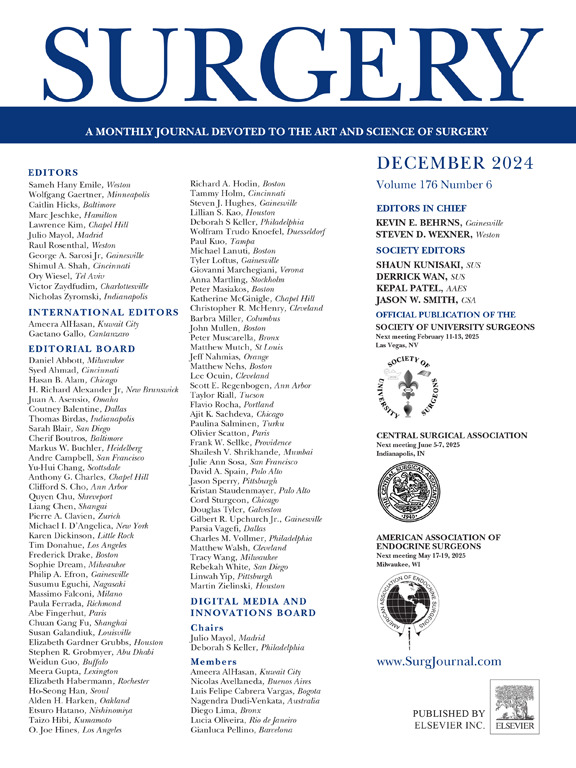术前门静脉栓塞术后肝功能不全:不只是体积
IF 3.2
2区 医学
Q1 SURGERY
引用次数: 0
摘要
背景:肝残余肥厚是肝大切除术前门静脉栓塞的主要终点。然而,即使将来获得足够的肝残余,术后肝功能不全也不能普遍避免。我们的目的是确定术前危险因素,术后肝功能不全,尽管使用门静脉栓塞。方法回顾性分析6家学术医疗中心门静脉栓塞术后肝大切除术患者的临床资料。术后肝功能不全定义为术后胆红素峰值7 mg/dL。分析术前与术后肝功能不全相关的变量。结果2008年至2019年,164例患者行门静脉栓塞后肝大切除术。20例(12%)患者术后出现肝功能不全。单因素分析显示,术后肝功能不全与年龄、运动状态、术前胆道引流、门静脉栓塞前后肝残余体积较小、胆管癌/胆囊癌诊断和术前胆管炎相关。即使在术后肝功能不全的情况下,也有明显的肝残余肥厚(从27%到39%);然而,术后肝功能不全组和非术后肝功能不全组的肥厚程度(100% vs 93%, P = 0.6)和动力生长率(95% vs 82%, P = 0.3)均无差异。在多变量分析中,胆管癌/胆囊癌的诊断和术前胆管炎(术后肝功能不全发生率分别为34%和62%)与术后肝功能不全独立相关,但与未来肝残量无关。术后肝功能不全使肝切除术后90天死亡率从3.5%增加到45%,住院时间从7天增加到16天(P <;措施)。结论术前虽行门静脉栓塞,术后仍有12%的肝大切除术患者出现肝功能不全。除了传统的容积信息外,外科医生还应注意术前胆管炎和胆管癌/胆囊癌是这一致命并发症的有力预测因素。本文章由计算机程序翻译,如有差异,请以英文原文为准。

Postoperative hepatic insufficiency despite preoperative portal vein embolization: Not just about the volumetrics
Background
Future liver remnant hypertrophy is the primary endpoint of portal vein embolization before major hepatectomy. However, even when adequate future liver remnant is achieved, postoperative hepatic insufficiency is not universally averted. We aimed to identify preoperative risk factors of postoperative hepatic insufficiency despite the use of portal vein embolization.
Methods
Patients who underwent portal vein embolization followed by major hepatectomy at 6 academic medical centers were retrospectively reviewed. Postoperative hepatic insufficiency was defined as postoperative peak bilirubin >7 mg/dL. Preoperative variables associated with postoperative hepatic insufficiency were analyzed.
Results
From 2008 to 2019, 164 patients underwent portal vein embolization followed by major hepatectomy. Twenty (12%) patients developed postoperative hepatic insufficiency. On univariate analysis, postoperative hepatic insufficiency was associated with older age, performance status, preoperative biliary drainage, smaller pre- and post-portal vein embolization future liver remnant volumes, diagnosis of cholangiocarcinoma/gallbladder cancer, and preoperative cholangitis. There was significant future liver remnant hypertrophy noted even in the setting of postoperative hepatic insufficiency (from 27% to 39%); however, degree of hypertrophy >5% (100% vs 93%, P = .6) and kinetic growth rate >2%/week (95% vs 82%, P = .3) did not differ between the postoperative hepatic insufficiency and non-postoperative hepatic insufficiency groups. On multivariate analysis, the diagnosis of cholangiocarcinoma/gallbladder cancer and preoperative cholangitis (postoperative hepatic insufficiency incidence 34% and 62%, respectively), but not future liver remnant volumetrics, were independently associated with postoperative hepatic insufficiency. Postoperative hepatic insufficiency raised post-hepatectomy 90-day mortality from 3.5% to 45% and hospitalization from 7 days to 16 days (both P < .001).
Conclusion
Postoperative hepatic insufficiency still occurs in 12% of patients after major hepatectomy despite preoperative portal vein embolization. In addition to traditional volumetric information, surgeons should be aware of preoperative cholangitis and cholangiocarcinoma/gallbladder cancer as powerful predictors of this fatal complication.
求助全文
通过发布文献求助,成功后即可免费获取论文全文。
去求助
来源期刊

Surgery
医学-外科
CiteScore
5.40
自引率
5.30%
发文量
687
审稿时长
64 days
期刊介绍:
For 66 years, Surgery has published practical, authoritative information about procedures, clinical advances, and major trends shaping general surgery. Each issue features original scientific contributions and clinical reports. Peer-reviewed articles cover topics in oncology, trauma, gastrointestinal, vascular, and transplantation surgery. The journal also publishes papers from the meetings of its sponsoring societies, the Society of University Surgeons, the Central Surgical Association, and the American Association of Endocrine Surgeons.
 求助内容:
求助内容: 应助结果提醒方式:
应助结果提醒方式:


